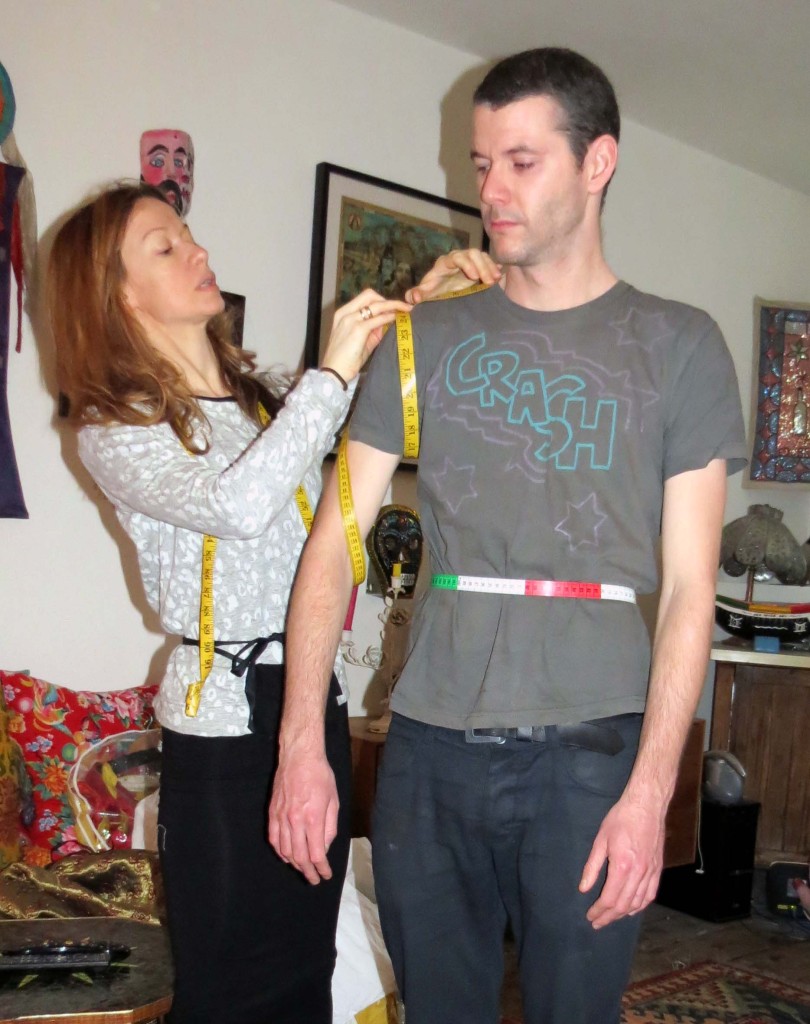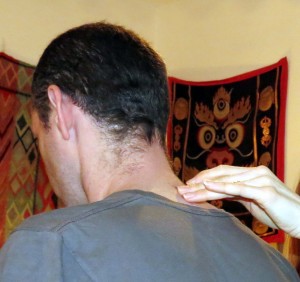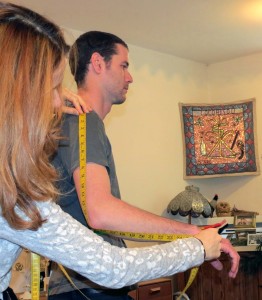Several months passed between my Tailoring Stitches and Techniques class and my Doublets class. Here Claire and Melanie took on five students: an experienced sempstress who works on an Elizabethan farm, a young woman who works on costuming in an opera house, a graduate student who has taken several other School of Historical Dress classes, and a brand new graduate student with no sewing experience whose adviser told her to sign up for this class but who had not at ALL anticipated how much this was a hands-on exercise (despite this, she did lovely work and kept an admirably cheerful spirit throughout). And me.
We had quite some time to get to know each other, spending six long days tight-packed around the table in Jenny’s workroom, all of us stitching together, learning together, confused together. We had time to talk, to tell stories. We talked about our lives and families, our jobs and hobbies, our homes and hassles. Many of us told stories not only about our partners and children, but of our mothers and grandmothers. Stories about sewing, cooking, teaching and more. We ate lunch together around Jenny’s kitchen table, took tea together every time it was offered, and politely shared the melt-in-your mouth homemade shortbread cookies and assorted sweets. When class ended, it almost seemed as if we were friends.
Patterning Doublets: the Toile
One key thing that I knew I’d learn in the doublet class – because in other classes, students had talked about it, and about how difficult it was – was how to design a pattern. This is something I have attempted before, but I was sure I’d have a lot to learn.
I did.
We started with something familiar to me: draping a toile, or muslin, which is also sometimes called a pattern block. (Toile is apparently a British term and muslin the American, but because most of the authors I read for costume information – Sarah Thursfield, Janet Arnold, the Tudor Tailor team – are British, some of the UK terminology is more familiar to me than the US versions.) What this means is taking large pieces of inexpensive fabric, often medium weight unbleached cotton, and pinning it snugly around a person so as to capture their three-dimensional shape. When you remove the pins and lay it out, you have two dimensional pattern pieces.
I won’t try to tell you how to drape a toile – there are books and websites out there that will do a better job. I learned by reading Sarah Thursfield’s Medieval Tailor’s Assistant. Later I took a workshop taught by Drea Callicut in how to fit and pattern a self-supporting linen kirtle (known in Society for Creative Anachronism circles as a Gothic fitted gown, or GFG). She used the instructions created by Charlotte Johnson (How to Pattern a Gothic Fitted Dress). With coaching and practice, I got better.
Since our class lacked a model, we fitted a full size articulated dressmakers dummy. Smooth, pin, pinch, pin, repin, shift, wiggle, pin, mark your pin lines, remove the toile. No need to ask whether he was comfortable, or would he lift that arm, or “oh, I’m so sorry! I didn’t mean to prick you!” or “I told you not to look down at me while I’m pinning, it changes the way this drapes on you, please stand up straight like I asked.” He was easy to work with.
We also took his measurements. Later, we had a live model come in for a fitting, and were shown again exactly where on the body to start and end each measurement. I learned a few useful tips:
If you start by fixing something around the person’s waist (his actual waist, not where he’s used to his trousers sitting) – something like a tape measure or a belt – and make sure it doesn’t shift while you’re working, you have a useful baseline for many measurements. You need to measure from under his arm to his waist, and from the nape of his neck to his waist, and maybe even total distance over the shoulder from front waist to back waist. If you have that waist point clearly marked, you’ll be able to take more accurate measurements more quickly.
But you’ll still do a bit of poking hard to find the bone for things like the shoulder point.
When you need to find the nape of the neck, have him tip his head forward. The bone that sticks out is the nape of the neck.
The doublet sleeves should be snugly fitted, just like the body. If the gentleman being fitted flexes his arm as pictured below, you can measure the outside and the inside of the arm and get a better idea of how much length you’ll need to keep the finished sleeve from riding up well past his wrist.
I feel as if I should be able to point you, the reader, to a useful list of what measurements you need to take, but I cannot think of one. We received a handout from class, but of course the School of Historical Dress holds that copyright, and I cannot post it here. If you know of a book or website with this information, please share!
Patterning Doublets: Pattern Drafting
Then came the mind-whirling, amazing, hard to describe stuff. We watched as Claire and Melanie each drafted a pattern, but not in any way I’d ever done it before.
I’m used to taking the toile, laying it flat, and smoothing out the inconsistencies between the two halves of the toile. Even if you’re pinning on a very symmetrical person, each half of the toile will have a slightly different shape, and honestly most people are far from symmetrical. Then you add a bit where you want to pad and shape the garment differently than the basic human form – a bit more added in a nice rounded shape in front on the lower torso to make a peascod belly, say.
They took measurements, a huge piece of paper, and a compass. (An enormous beam compass like this one.) Although they looked at the toiles and measured a few parts of them, they didn’t use the shape of the toile as the basis of the pattern. After they drew the X and Y axes, every point they used, every curve, every straight line was created by casting circles from a previous point (or points). Every circle had a radius that related to a fractional part of a yard, or sometime to a fractional portion of some length that had already been plotted onto the pattern. They’d try one curve, decide they didn’t like it, try another. They’d need a point from which to cast a large, shallow curve – and they’d have to find two other possible curves cast from the pattern to create the point they needed.
If this doesn’t make sense, forgive me. I really haven’t wrapped my head around it yet. I need practice, lots of practice, before I will be able to really explain what they wanted us to learn.
Their patterns grew, bit by bit, with curves and points and lines that all had a numerical relationship to one another. Claire and Melanie had different “favorite” curves they preferred, or repeatedly found useful. They had different ways of describing what they did. But their technique was the same: geometrical construction and a whole lot of “that’s the way I think it should look.” Of course, Claire and Melanie have also studied extant garments and looked carefully at cutting diagrams in period tailoring manuals. The patterns they’ve observed in those heavily influence the choices they made as they shaped their patterns.
It was amazing. Mind blowing. And really, really hard to learn to do. Thankfully, we didn’t have to tackle that until the next day.
Please ask questions – it helps me figure out what I still haven’t described.



